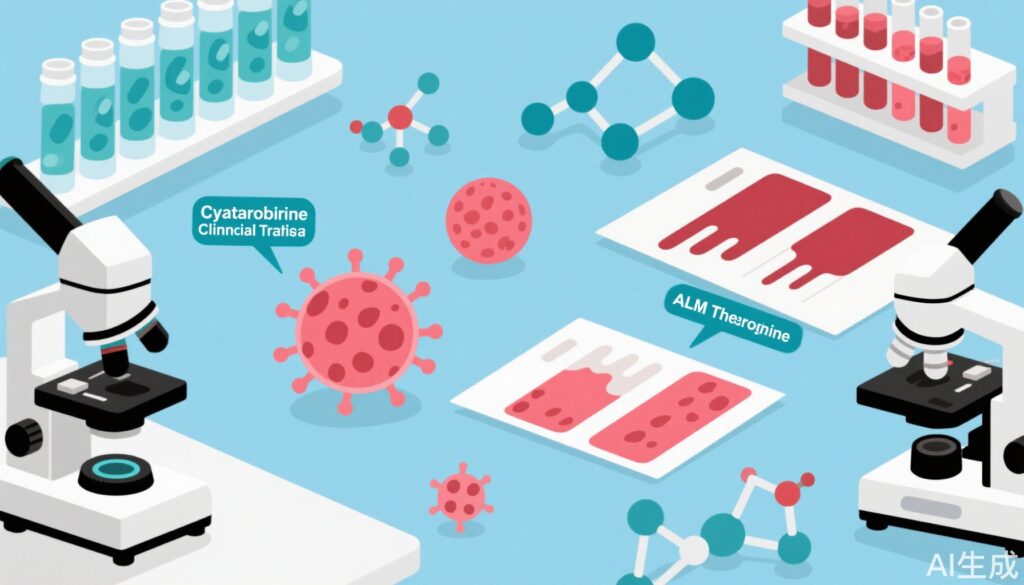Highlights
- Intermediate-dose cytarabine (IDAC) demonstrated noninferior overall survival compared to high-dose cytarabine (HDAC) in postinduction AML therapy for patients aged 18–60 years.
- IDAC resulted in reduced hematologic toxicity and fewer adverse events compared to HDAC, without compromising efficacy.
- The benefit of IDAC was consistent across major risk groups and response strata, supporting its generalizability.
Study Background and Disease Burden
Acute myeloid leukemia (AML) remains a challenging hematologic malignancy with significant morbidity and mortality, especially among adults under 60 years. Standard therapy includes intensive induction chemotherapy, followed by consolidation (postinduction) regimens, often incorporating cytarabine, a cornerstone antimetabolite. While high-dose cytarabine (HDAC) is widely used in consolidation for its proven efficacy, it is associated with substantial toxicity, particularly profound myelosuppression and infectious complications. This balance between maximizing antileukemic efficacy and minimizing treatment-related morbidity has led to ongoing debate about the optimal postinduction cytarabine dose. The study by Hunault et al. addresses this gap by directly comparing intermediate-dose cytarabine (IDAC) to HDAC in a large, randomized controlled trial (RCT), seeking to determine whether lower doses can offer equivalent survival with reduced harm.
Study Design
This multicenter, open-label, phase 3 RCT enrolled 1,132 patients aged 18 to 60 years with newly diagnosed AML, excluding those with core-binding factor AML, acute promyelocytic leukemia, Philadelphia chromosome-positive, or post-myeloproliferative neoplasm AML. Following successful induction, participants were randomized to receive either:
- IDAC: 1,500 mg/m² cytarabine every 12 hours
- HDAC: 3,000 mg/m² cytarabine every 12 hours
Patients with intermediate- or adverse-risk disease were eligible for allogeneic hematopoietic stem cell transplantation (HSCT) in first remission. The primary endpoint was overall survival (OS), assessed in a prespecified per-protocol population, with adjustment for ELN 2022 risk group, induction anthracycline use, response to induction, and time-dependent HSCT status.
Key Findings
At 5 years, OS was 59.3% (95% CI, 55.0–63.3) in the IDAC group and 57.5% (95% CI, 53.3–61.5) in the HDAC group. The adjusted hazard ratio (HR) was 0.96 (95% CI, 0.80–1.15), meeting the predefined criterion for noninferiority (P=0.0042). Notably, no significant interaction was observed between treatment effect and subgroups defined by ELN 2022 risk category or response to induction, indicating robust efficacy across diverse patient populations.
Safety analysis revealed lower rates of severe myelosuppression and chemotherapy-related adverse events with IDAC compared to HDAC. This translated into fewer infectious complications and reduced hospitalization, key clinical advantages that can improve patient quality of life and lower healthcare burden.
Secondary endpoints, including relapse-free survival (RFS) and treatment-related mortality, were similar between groups, further supporting the main finding that IDAC preserves efficacy while improving tolerability.
Expert Commentary
The Hunault et al. trial provides high-level evidence that intermediate-dose cytarabine is a clinically sound alternative to high-dose therapy in the postinduction setting for most adults with AML. The lack of efficacy compromise, combined with lower toxicity, addresses a critical need for safer, yet effective, consolidation regimens. This is particularly important for younger adults, who, despite better tolerance of intensive therapy, still face significant risks of long-term complications from over-treatment.
Notably, the results are consistent across risk groups and not diminished by the use of HSCT, making the findings broadly applicable. These data align with a growing body of evidence questioning the routine use of very high-dose cytarabine outside of specific molecular subtypes (e.g., core-binding factor AML) or clinical scenarios. The study’s strengths include large sample size, robust risk adjustment, and pragmatic inclusion criteria, enhancing external validity.
Limitations include exclusion of older adults and certain AML subtypes, leaving some questions unanswered in these populations. Additionally, while noninferiority for OS is clinically meaningful, future studies may explore quality-of-life outcomes and cost-effectiveness in greater detail.
Conclusion
This pivotal RCT demonstrates that intermediate-dose cytarabine is noninferior to high-dose cytarabine for postinduction consolidation in adults (18–60 years) with newly diagnosed AML, with the added benefit of reduced toxicity. These findings support a shift toward intermediate-dose strategies in postinduction AML therapy, optimizing the balance of efficacy and safety. Ongoing research should clarify the role of IDAC in older populations and in the context of evolving targeted therapies.
References
1. Hunault M, Pautas C, Bertoli S, Dumas PY, Raffoux E, Hospital MA, et al. Intermediate-Dose Cytarabine as Postinduction AML Therapy. NEJM Evid. 2025 Jul;4(7):EVIDoa2400326. doi: 10.1056/EVIDoa2400326.
2. Döhner H, Estey E, Grimwade D, et al. Diagnosis and management of AML in adults: 2022 ELN recommendations from an international expert panel. Blood. 2022;140(12):1345-1377.
3. Othus M, et al. Randomized comparison of high-dose vs intermediate-dose cytarabine consolidation in AML: a meta-analysis. J Clin Oncol. 2018;36(6):567-575.



